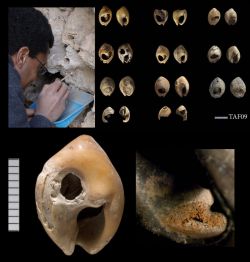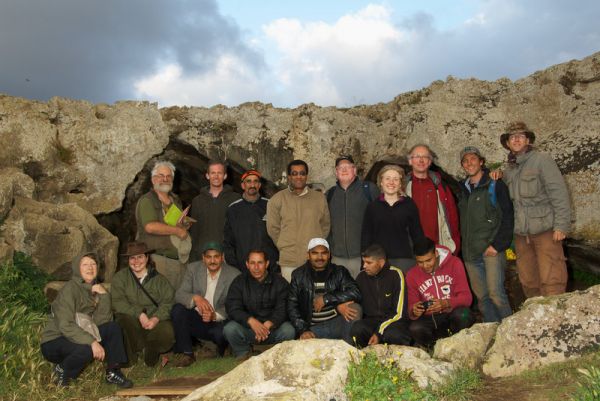Morocco Caves Project
Early modern humans and the origins of symbolism in North Africa

Professor Nick Barton, Institute of Archaeology Oxford (Principal Investigator), Prof. A.Bouzougger Institut National des Sciences de l’Arche´ologie et du Patrimoine, Rabat, Morocco. (Principal Investigator)
Some of the earliest evidence for symbolically modern behavior in humans occurs in North Africa around 80,000 years ago, and anticipates by some forty thousand years similar developments in Europe that have been termed the ‘Upper Palaeolithic Revolution’. In Africa such activity is first recognised in the Middle Stone Age (MSA) in the form of personal ornaments such as Nassarius marine shell beads that are perforated and coloured with pigments and are sometimes found hundreds of kilometers inland from the coast. However, such claims are founded on relatively limited archaeological evidence and are not as well dated as the more prolific examples from the Upper Palaeolithic of Europe. Moreover, it has not yet been demonstrated whether the beads and pigments were isolated occurrences or were part of a staged increase in complexity within MSA culture.

In North Africa early examples of shell ornaments and red ochre have been recovered at a small number of MSA Aterian sites in Northeastern Morocco and Algeria. The Aterian culture characterised by distinctive tanged stone points has a much wider distribution covering the Sahara and its margins as far east as Egypt. Ideas are deeply divided on its origins. Some suggest that it was spread from East Africa by anatomically modern Homo sapiens who crossed a ‘greener’ Sahara during the MIS-5 interglacial 130,000 years ago. However, human fossils are very rare in the Aterian making it difficult to verify such claims and some of the earliest dates for the Aterian now come from Northwest rather than Northeast Africa. Our preliminary findings also suggest that where shell beads occur this was not an isolated phenomenon but was accompanied by other cultural innovations such as the appearance of hafted stone tools, equipment in novel materials (bone and ivory), and linked to the introduction of new hunting practices, the seasonal scheduling of activities, a more structured use of domestic space and long distance exchange. Evidence for MSA complexity is present at one site in the Mediterrean zone (Grotte des Pigeons at Taforalt) but if similar patterns can be demonstrated more widely for the Aterian then it would indicate little difference with features of the Upper Palaeolithic and would be further proof that symbolic and cognitively modern behaviours appeared in African humans long before they did in Europe.
In order to critically evaluate evidence for claims of early symbolism in North Africa we are testing other caves on the Atlantic coast of Morocco closer to known natural sources of Nassarius shells along raised beaches of the same coastline. In particular we will investigate the idea that Atlantic sources were exploited for these shells by MSA humans and that the earliest shell beads originate from this area and in association with complex Aterian culture.
The 2012 season, funded by Oxford University’s Fell Fund and the Calleva Foundation, focused on the survey and excavation at Dar es-Soltan 1 Cave . The cave is one of several caves that lie close together, opening from a low cliff on the Atlantic coast on the outskirts of Rabat. It is a multi-layered site, composed of a 7.5 m deep sequence and containing at least three MSA Aterian layers.
.
The aim of the 2012 season was to:
- Document and photographically record finds utilising the new method of RTI photography (Reflectance Transformation imaging) and 360 object rotation photography
- Undertake a full topographic survey of the cave and its deposits; record the site’s 7.5 high sections using a combination of 360-degree digital imagery and Total Station 3D measurements of the cave interior and exterior, and to illustrate the position of the site in the wider landscape setting.
- Collect a wide range of palaeoenvironmental evidence from each of the stratigraphic levels that will enable the reconstruction of changing climatic conditions since the last interglacial (MIS-5).
- Undertake further dating studies to refine the chronological understanding of this site.
- Sample the fossil beach at the base of the sequence, to obtain natural Nassarius shells and to determine isotopically whether these were the source of perforated beads found at other Aterian sites, for example in the Mediterranean zone.
* RTI Photography: A hand axe found close to Dar es-Soltan was photographed using RTI photography to reveal surface information that is not disclosed under direct empirical examination of the physical object.
* 360 object: Examine the hand axe by rotating the object to provide a 360° view. (Available ONLINE soon)
* 360 digital imagery: Excavation at Dar es-Soltan 1 Cave (DeS I) 360-degree digital photography was employed for the cave interior and exterior, and to illustrate the position of site in the wider landscape setting.
* ARCH DAMS image data base: (note: Site photographic record for team member access only) To gain permission to access the photographic record please contact the principal investigators.

All images © Copyright Oxford University Institute of Archaeology, Ian R.Cartwright - 2013
To view the RTI files below (which can be downloaded to your computer) you will need an RTI viewer, which is available at http://culturalheritageimaging.org/What_We_Offer/Downloads/View/index.html
To download the file below to view, RIGHT CLICK on it and choose SAVE FILE AS (or DOWNLOAD FILE AS).





